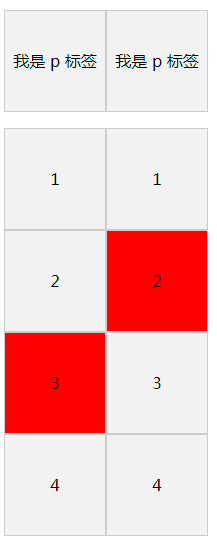登陆可实现PC、移动端同步进度.
nth 元素选择
当我们要一组 class 同名,或者连续的一组元素的其中一个,或者某种规律的元素添加单独样式的时候,不妨看看这类的元素选择器。
1. 官方定义
nth-child(n)选择器匹配属于其父元素的第 N 个子元素;nth-last-child(n)选择器匹配属于其元素的第 N 个子元素的每个元素,从最后一个子元素开始计数;nth-of-type(n)选择器匹配属于父元素的特定类型的第 N 个子元素的每个元素。
2. 慕课解释
nth-child(n)、 nth-last-child(n) 、nth-of-type(n) 都是用来匹配父元素内部子元素的。不过也有些区别:nth-child 按照个数来算;nth-of-type 按照类型来计算;nth-last-child(n) 从最后一个子元素往前开始计算。
3. 语法
.item:nth-child(2n+1){
}
.item:nth-of-type(n){
}
.item:nth-last-child(2n){
}
n 从 0 开始计数的正整数。
4. 兼容性
| IE | Edge | Firefox | Chrome | Safari | Opera | ios | android |
|---|---|---|---|---|---|---|---|
| all | all | all | all | all | all | all | all |
5. 实例
选择 demo 内第 3 个子元素背景为红色。
- 使用
nth-child。
.item{
width: 100px;
height: 100px;
text-align: center;
line-height: 100px;
border: 1px solid #ccc;
background: #f2f2f2;
}
.item:nth-child(3){
background: red;
}
效果图:

实例演示
预览
复制
<!DOCTYPE html>
<html lang="en">
<head>
<meta charset="UTF-8">
<meta name="viewport" content="width=device-width, initial-scale=1.0">
<title>Document</title>
<style>
.item{
width: 100px;
height: 100px;
text-align: center;
line-height: 100px;
border: 1px solid #ccc;
background: #f2f2f2;
}
.item:nth-child(3){
background: red;
}
</style>
</head>
<body>
<div class="demo">
<div class="item">1</div>
<div class="item">2</div>
<div class="item">3</div>
<div class="item">4</div>
</div>
</body>
</html>
运行案例 点击 "运行案例" 可查看在线运行效果
- 使用
nth-last-child。
.item{
width: 100px;
height: 100px;
text-align: center;
line-height: 100px;
border: 1px solid #ccc;
background: #f2f2f2;
}
.item:nth-last-child(2){
background: red;
}
效果图
实例演示
预览
复制
<!DOCTYPE html>
<html lang="en">
<head>
<meta charset="UTF-8">
<meta name="viewport" content="width=device-width, initial-scale=1.0">
<title>Document</title>
<style>
.item{
width: 100px;
height: 100px;
text-align: center;
line-height: 100px;
border: 1px solid #ccc;
background: #f2f2f2;
}
.item:nth-last-child(2){
background: red;
}
</style>
</head>
<body>
<div class="demo">
<div class="item">1</div>
<div class="item">2</div>
<div class="item">3</div>
<div class="item">4</div>
</div>
</body>
</html>
运行案例 点击 "运行案例" 可查看在线运行效果
- 使用
nth-of-type。
.item{
width: 100px;
height: 100px;
text-align: center;
line-height: 100px;
border: 1px solid #ccc;
background: #f2f2f2;
}
.item:nth-of-type(3){
background: red;
}
效果图

实例演示
预览
复制
<!DOCTYPE html>
<html lang="en">
<head>
<meta charset="UTF-8">
<meta name="viewport" content="width=device-width, initial-scale=1.0">
<title>Document</title>
<style>
.item{
width: 100px;
height: 100px;
text-align: center;
line-height: 100px;
border: 1px solid #ccc;
background: #f2f2f2;
}
.item:nth-of-type(3){
background: red;
}
</style>
</head>
<body>
<div class="demo">
<div class="item">1</div>
<div class="item">2</div>
<div class="item">3</div>
<div class="item">4</div>
</div>
</body>
</html>
运行案例 点击 "运行案例" 可查看在线运行效果
6. 经验分享
- 在实例中我们看到
nth-of-type和nth-child同样都使用的是 (3), 那么它们的不同是什么呢?下面这个例子我们一起看下:
<div class="demo">
<p class="item">我是 p 标签</p>
<div class="item">1</div>
<div class="item">2</div>
<div class="item">3</div>
<div class="item">4</div>
</div>
<div class="demo">
<p class="item-2">我是 p 标签</p>
<div class="item-2">1</div>
<div class="item-2">2</div>
<div class="item-2">3</div>
<div class="item-2">4</div>
</div>
.demo{
float: left;
}
.item,.item-2{
width: 100px;
height: 100px;
text-align: center;
line-height: 100px;
border: 1px solid #ccc;
background: #f2f2f2;
}
.item:nth-of-type(3){
background: red;
}
.item-2:nth-child(3){
background: red;
}
效果图

通过效果图我们就清楚的明白他们的差异了。
简述实例展现效果,通过实例分析他们两个的区别
实例演示
预览
复制
<!DOCTYPE html>
<html lang="en">
<head>
<meta charset="UTF-8">
<meta name="viewport" content="width=device-width, initial-scale=1.0">
<title>Document</title>
<style>
.demo{
float: left;
}
.item,.item-2{
width: 100px;
height: 100px;
text-align: center;
line-height: 100px;
border: 1px solid #ccc;
background: #f2f2f2;
}
.item:nth-of-type(3){
background: red;
}
.item-2:nth-child(3){
background: red;
}
</style>
</head>
<body>
<div class="demo">
<p class="item">我是 p 标签</p>
<div class="item">1</div>
<div class="item">2</div>
<div class="item">3</div>
<div class="item">4</div>
</div>
<div class="demo">
<p class="item-2">我是 p 标签</p>
<div class="item-2">1</div>
<div class="item-2">2</div>
<div class="item-2">3</div>
<div class="item-2">4</div>
</div>
</body>
</html>
运行案例 点击 "运行案例" 可查看在线运行效果
下面是让所有偶数的背景变红。
.item{
width: 100px;
height: 100px;
text-align: center;
line-height: 100px;
border: 1px solid #ccc;
background: #f2f2f2;
}
.item:nth-of-type(2n){
background: red;
}
效果图:

实例演示
预览
复制
<!DOCTYPE html>
<html lang="en">
<head>
<meta charset="UTF-8">
<meta name="viewport" content="width=device-width, initial-scale=1.0">
<title>Document</title>
<style>
.item{
width: 100px;
height: 100px;
text-align: center;
line-height: 100px;
border: 1px solid #ccc;
background: #f2f2f2;
}
.item:nth-of-type(2n){
background: red;
}
</style>
</head>
<body>
<div class="demo">
<div class="item">1</div>
<div class="item">2</div>
<div class="item">3</div>
<div class="item">4</div>
</div>
</body>
</html>
运行案例 点击 "运行案例" 可查看在线运行效果
- 使用
nth-of-type(3n+1)起作用,而nth-of-type(1+3n)不起作用,所以n一定要放在最前面。
- 还没有人评论,欢迎说说您的想法!




 客服
客服


